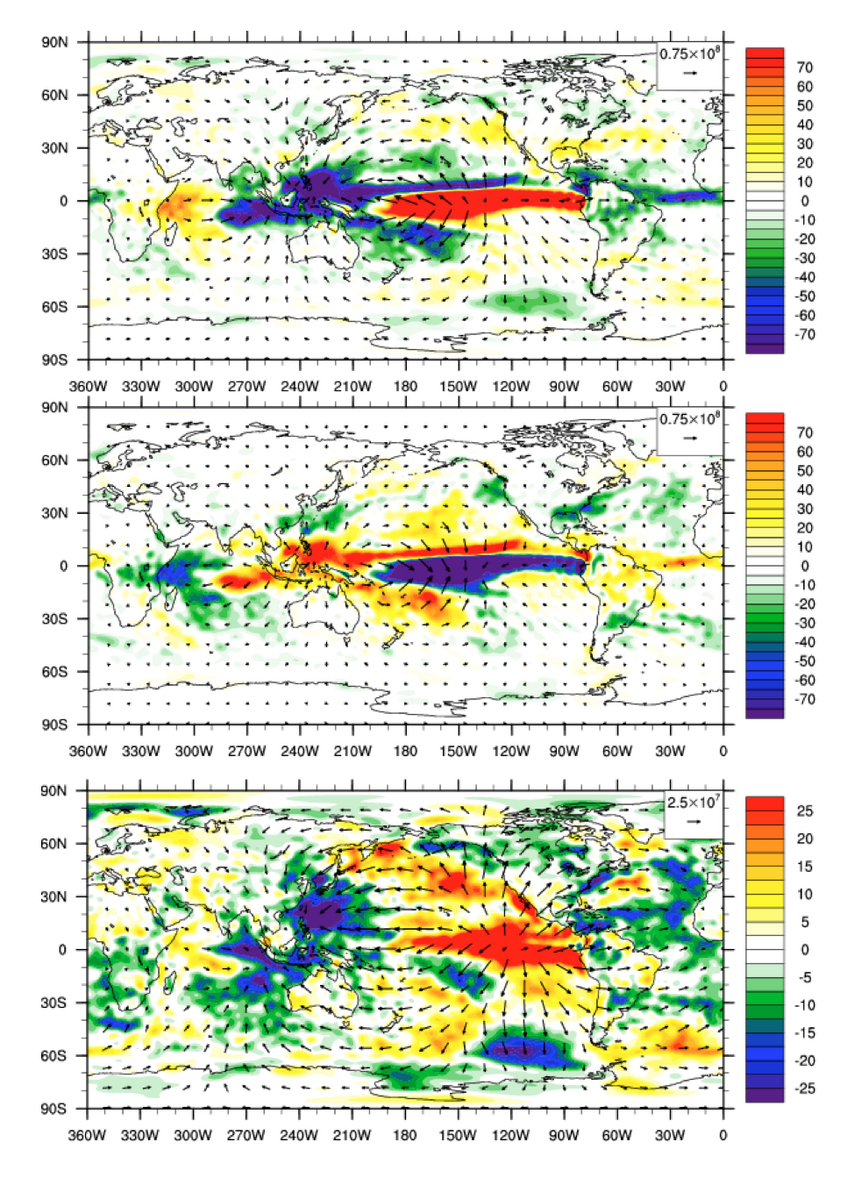Global Energy Transports
Diagnostics of energy exchanges in coupled atmospheric and oceanic energy budgets
Global reanalyses of the atmosphere and ocean are valuable tools for quantitative assessment of the global energy budget.
In a vertically integrated framework, net surface flux (FS) is balanced in the atmosphere by local atmospheric energy storage (AET), divergence of horizontal atmospheric energy transport and net radiation at top of the atmosphere (RadTOA):
FS = - AET – DIVFA + RadTOA
In the ocean, net surface flux is balanced by the local tendency of ocean heat content (OHCT) and the divergence of horizontal oceanic energy transport (DIVFO).
FS = OHCT + DIVFO
Comparison of eqs. (1) and (2) shows that the sum of the atmospheric budget terms must balance the sum of the oceanic budget terms. This is generally not the case due to the imperfect data quality of current reanalysis products. For example, global mean anomalies of earth’s net radiation budget (RadTOA) should be replicated in variability of globally averaged OHCT, because the atmosphere’s heat capacity is relatively small and the global average of the divergence terms should vanish by definition, but current reanalyses show this feature only to a very limited extent. Reasons for these inconsistencies are the generally sparse ocean observation system - especially prior to the 2000s – and temporal inhomogeneities due to changes of the observation system.
However, the results presented here show that on the spatial scale of tropical ocean basins energy exchanges between atmosphere and ocean in association with the prominent El Niño – Southern Oscillation (ENSO) phenomenon can be consistently quantified, yielding interesting new insights into the response of the climate system to ENSO.
Regression analysis with reanalysis data shows that during peak El Niño (La Niña) 80% of the tropical Pacific heat loss (gain) is compensated by an increase (decrease) of oceanic heat content in the tropical Indian ocean and the Atlantic. Only the remaining 20% of the energy is exchanged with space as net radiation at TOA. The energy exchange between the tropical ocean basins is realized indirectly via the atmosphere. It results from ample changes of the atmospheric circulation (teleconnections) and associated changes of clouds, radiation and consequently altered surface energy exchanges. The contribution of oceanic energy export from the tropics is negligible, only the Indonesian Throughflow region exhibts noteworthy variability of heat transports in association with ENSO.
These results lead to an extension of the established picture that during El Niño/La Niña oceanic heat is mainly redistributed within the tropical Pacific and that the rest is exchanged at TOA. In fact, a sizeable amount of oceanic energy is redistributed between tropical ocean basins. See Fig. 1 for a schematic of the just described energy exchanged.
Moreover, our results can also explain, why the global average variability of RadTOA in association with ENSO is small compared to the variability of the tropical Pacific ocean heat content. See the publications cited below for more details.
Researcher:
Projects:
Publications:
- Mayer, M., Haimberger, L., and Balmaseda, M. A., 2014: On the energy exchange between tropical ocean basins related to ENSO. Journal of Climate.
- Mayer, M., Trenberth, K. E., Haimberger, L, Fasullo, J. T., 2013: The Response of Tropical Atmospheric Energy Budgets to ENSO. Journal of Climate, 26, 4710-4724.
- Mayer, M., and Haimberger, L., 2012. Poleward atmospheric energy transports and their variability as evaluated from ECMWF reanalysis data. Journal of Climate, 25, 734–752.

Fig. 1: Composites of dry static energy (top), latent heat (middle) and total energy divergence (bottom) anomalies (based on six-monthly smoothed fields) for the peak phase of the three strongest El Niños during the ERA-interim period (1982/83, 1986/87, 1997/98); Divergences (contours) in W/m^2, transports (vectors) in W/m.. (© IMGW)

Fig. 2: Schematic of anomalous energy fluxes within and between tropical atmosphere and oceans. Depicted is anomalous divergence of atmospheric energy transport, anomalous fluxes at the surface (RadS denotes net radiation at the surface, LH and SH latent and sensible heat flux, respectively), at TOA and anomalous heat transport by the Indonesian Throughflow (ITF, yellow arrows), as well as anomalous sea surface temperature (SST) and ocean heat content tendency (OHCT) as a response to El Niño (based on regression of energy budget fields with Niño 3.4 – SST index as ENSO proxy). Note the strong west-east compensation of OHCT in the Pacific which is due to zonal oceanic heat transports. White arrows in the atmosphere indicate circulation anomalies in the vertical-equatorial plane associated with the Walker cells. (© IMGW)
